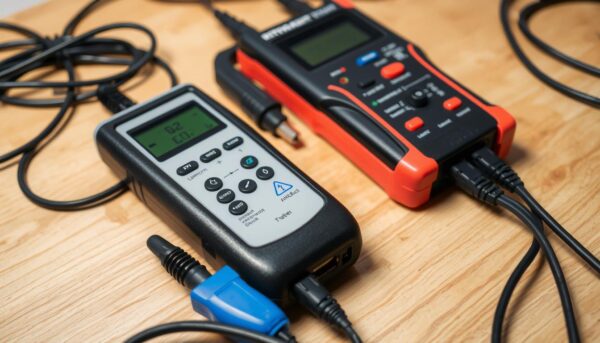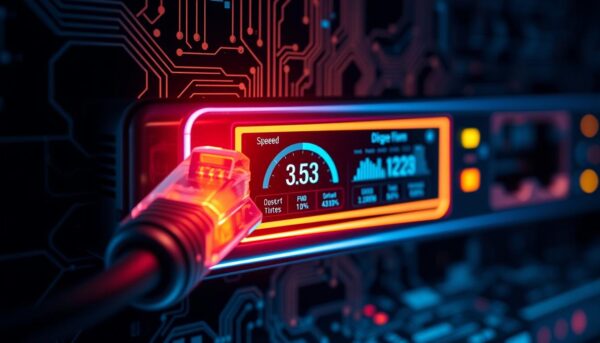✅ Last checked on
Having a reliable Ethernet connection is key for work or streaming. But, issues can pop up due to physical problems, software glitches, or network setup mistakes. Troubleshooting Ethernet is vital to fix these problems fast and keep your network running smoothly.
These issues can cause slow speeds, dropped connections, or no connection at all. It’s frustrating and can slow you down.
Network troubleshooting helps solve Ethernet problems. About 20% of issues come from wrong DNS settings. Network congestion and server overload also cause drops. Around 25% of problems are due to cabling damage or disconnection, shown by a dark link LED.
Knowing the common causes helps prevent Ethernet problems. Most issues come from local or network setup errors. Using troubleshooting methods can fix these problems and keep your network stable.
Key Takeaways
- Physical connection issues, software-related problems, and network configuration errors can cause Ethernet connection issues.
- Approximately 20% of Ethernet connection issues stem from improperly configured DNS settings.
- Network congestion and overloaded servers can lead to connection drops, with occurrence rates reported at 15-30% during peak usage times.
- Damage or disconnection of cabling is responsible for around 25% of issues, often indicated by a non-illuminating link LED.
- Ethernet troubleshooting techniques can help you identify and resolve Ethernet connection issues, ensuring a stable and efficient network.
- Regular network maintenance and troubleshooting can help prevent Ethernet connection issues and ensure a reliable connection.
Understanding Common Ethernet Connection Problems
When you face Internet connection issues, finding the main problem is key. Ethernet error codes can help you understand what’s wrong. Most Ethernet problems fall into three areas: physical, software, and network setup.
To fix Internet issues, start by checking the physical connection. Look for loose plugs, damaged cables, or wrong cable use. Make sure the Ethernet cable is well connected to both your device and the router or switch. If you’re using a wireless router, make sure you’re connected to the right network.
Physical Connection Issues
Physical problems can stem from bad or wrong Ethernet cables. Standard Ethernet cables work well up to 100 meters. But, a damaged or low-quality cable can cause issues. Try swapping the cable or looking for any damage.
Software-Related Problems
Software issues might come from wrong network settings or old drivers. Make sure your network settings are right and drivers are current. Resetting network settings to default can also help.
Network Configuration Errors
Network setup mistakes can happen with wrong DNS or IP settings. Check if your device gets a valid IP from the DHCP server. You might need to set IP and DNS manually to fix problems.
Knowing the common causes of Ethernet problems helps you solve them. Always check the physical connection, software, and network setup to find the main issue.
Quick Ethernet Troubleshooting Steps
To fix Ethernet connection issues, start by checking the physical connection. Make sure the Ethernet cable is well-plugged into both your computer and the router or switch. This basic step can often solve problems.
Then, look at your computer’s network adapter settings. Ensure the Ethernet connection is turned on and set up right. Try plugging the cable into a different port on the hub, switch, or router. This can show if the problem is with the port or the cable.

- Check for loose or damaged cables
- Restart your router or switch
- Update your Ethernet adapter drivers
- Disable any VPNs or proxy servers that may be interfering with your connection
By taking these quick steps, you can quickly find and fix Ethernet connection issues. This ensures a stable and reliable connection.
Ethernet was first released in 1980. It has since become a widely used local-area network (LAN) protocol. Ethernet and IEEE 802.3 hold the largest market share of any LAN protocol.
Advanced Network Diagnostics and Solutions
To fix common Ethernet problems like slow speeds or dropped connections, you can use advanced tools. Troubleshooting Ethernet speed means understanding your network well. This helps you find and fix issues for better network performance and a stable connection.
Some Ethernet issues might cause slow speeds, dropped connections, or total network failure. You can use Windows tools like the Network Troubleshooter or third-party software like Wireshark. These tools help you see network traffic, check for errors, and track how well your network is working.
Using Built-in Windows Tools
Windows has tools to help with Ethernet problems. For example, the Network and Sharing Center can show your network status and find issues. You can also use the Command Prompt to run commands like “ipconfig” and “ping” to check network connections.
Third-Party Diagnostic Software
Third-party software offers more features to solve Ethernet issues. For instance, SolarWinds Network Performance Monitor can gather network data and give detailed analysis to find problem causes.

Command Line Troubleshooting
Using the command line is a good way to find and fix Ethernet problems. Commands like “nslookup” and “ping” can test DNS and network connections. Tools like NetPath and PerfStack can also show network paths and performance, helping you spot issues.
| Tool | Description |
|---|---|
| Network Troubleshooter | Identifies and resolves common network issues |
| Wireshark | Captures and analyzes network packets |
| SolarWinds Network Performance Monitor | Collects and analyzes network performance data |
Essential Ethernet Cable Maintenance and Testing
To keep your Ethernet connection working well, regular maintenance and testing are key. You should check for damage, verify cable quality, and manage cables properly. Issues like physical damage, poor quality, or wrong installation can happen. Using diagnostic tools can help find and fix these problems, cutting down on downtime and boosting network performance.
Common problems like slow speeds, intermittent connections, and lost connections can be fixed early. This prevents bigger issues and keeps your Ethernet connection stable. Good cable management also helps avoid damage, lowering the chance of problems and enhancing network performance.
Regular checks can spot issues before they cause trouble, and testing cables on schedule can cut down troubleshooting time by 50%. Shielded cables can also cut EMI impacts by 70% in industrial areas. By following these steps and using the right tools, you can keep your Ethernet cables in top shape. This reduces the risk of problems and improves your network’s performance.
| Cable Type | Data Transmission Speed | Bandwidth |
|---|---|---|
| Cat5e | Up to 1 Gbps | 100 MHz |
| Cat6 | Up to 10 Gbps | 250 MHz |
| Cat7 | Up to 40 Gbps | 600 MHz |
Router and Network Interface Card Troubleshooting
To fix Ethernet connectivity issues, start by checking your router and network card. Look at the router’s settings and make sure the network card is working right. For more DIY network troubleshooting tips, visit network guides.
Network card problems can show up as LED lights that don’t light up or are orange or red. A steady green light means you’re connected, while a flashing light means data is being sent. Use the ping command to test your network card. If you get no replies, it might be a card or connection issue.
Here’s how to troubleshoot your router and network card:
- Check the router’s configuration and verify the network adapter
- Verify the physical connections, including cables and ports
- Check for firmware updates and install them if necessary
- Use the tracert command to identify connectivity failures in the network
By following these steps, you can find and fix Ethernet connectivity issues. Don’t forget to check your Internet Service Provider (ISP) and make sure your network card settings are right, including DNS server addresses.
| Issue | Solution |
|---|---|
| Defective network card | Replace the network card |
| Improperly connected network card | Verify the physical connections |
| Outdated firmware | Install firmware updates |
By fixing your router and network card, you can solve Ethernet connectivity problems. Always check for Ethernet error codes and fix them to avoid future issues.
Conclusion: Maintaining a Reliable Ethernet Connection
Troubleshooting Ethernet connection issues is key for a smooth internet experience. Knowing common problems helps you fix them before they cause trouble. This way, you can keep your Ethernet network running well.
Regular upkeep is important. Check your cables, manage them well, and update your firmware. Also, use Windows tools and third-party diagnostics to find and fix problems with your router or network card.
An Ethernet connection can reach speeds of up to 100 Gbps with the right gear. By following the steps in this article, you can keep your Ethernet connection fast, reliable, and top-notch.